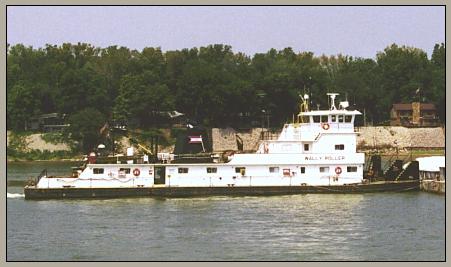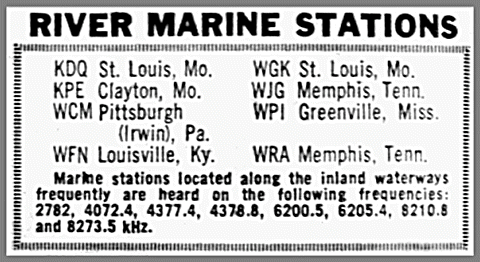
Inland Rivers

Mv. Wally Roller (WDD4358) at Jeffersonville - August 2001 Archivist Photo
Mississippi River history would be incomplete without recognition of the important role of the commercial radio communications stations that served the inland rivers towboats. There was CW operation on some government boats in the 1920s and 30s, with commercial use of CW starting on a very modest scale in the early 1940s (perhaps even the late 1930s). It appears that there were radio officers, who often doubled as clerks, on some of the boats. This RMCA 1946 document indicates that WGK was using CW at that time.
Commercial ship-to-shore radiotelephone communications serving the towboats on the Mississippi started with operations by WJG in Memphis, TN in 1936. By the early 1950s there were five stations (WAY, WCM, WFN, WGK and WJG) providing towboat communications on the Mississippi, Ohio, Tennessee, Monongahela and other inland rivers. In addition to these 5 stations the FCC Annual Reports indicate that they licensed another Coastal Harbor station, KMP, at Cape Girardeau, MO. It was first licensed in 1941 (probably only on MF), and in 1943 it was seeking "additional frequencies - - - - to extend the communication range of this station substantially." Probably requesting 4, 6 & 8 MHz frequencies. However, Jack Estes reports that the principals in this station, the Erlbacher brothers Robert and Eddie who had a shipyard, dry dock and several towboats, never put it on the air.
This excerpt from the 1941 FCC Annual Report gives a concise picture of the status of both radiotelephony and radiotelegraphy on the rivers at that time.
These stations first used AM (amplitude modulation) and later switched to SSB (single sideband) for their operations. The FCC authorized frequencies in the 2, 4, 6, 8 and later 12 MHz bands for this service. The inland rivers stations operated in the simplex mode with the shore stations and the boats on the same frequency - alternately transmitting and receiving. The professionals may have considered this inferior to the semi-duplex (or was it full-duplex??) arrangement used on the high seas and Great Lakes. However, the simplex mode made it easy for a SWL (shortwave listener) to easily hear both sides of the conversation.
Don't know where to put this, so it goes here. In 1947 the California steamboat Delta Queen was towed down the Pacific coast, through the Panama Canal and Gulf of Mexico to New Orleans and then up the Mississippi and Ohio to Pittsburgh where it was refurbished for excursion service on the rivers. The June 2022 issue of the S & D Reflector, a publication of Sons and Daughters of Pioneer Rivermen, reports that the FCC authorized a tw0-month license for the boat's journey. The call letters KSCV were issued for the boat's 10 Watt transmitter.
 |
This table is from the winter 1971 Communications World Magazine -
Courtesy of Max Summerville, W8MMS. WAY - Chicago is missing from the list. |
|---|---|
It seems that the FCC was not convinced of the need for marine communications on the rivers. Witness the difficulties WJG had getting the first inland rivers license, the assignment of simplex vs. duplex frequencies and the sparse frequency allocations for the river stations. In the early days all 4 stations shared one 2 MHz frequency, two 4 MHz frequencies, two 6 MHz frequencies and one 8 MHz frequency. Corrections requested here. Later the FCC became more generous and while sharing of the 2 MHz channel continued each station was authorized an exclusive 4, 6 and 8 MHz channel and shared 12 and 16 MHz channels with only one other station. As far as I know the 16 MHz channels were never used. With the advent of VHF-FM marine communications it appears that the 2 MHz channel was eventually withdrawn.
The communications services to the boats provided by these stations included the boat position reports, river stage broadcasts, and "phone-patches" to land-line telephones for both business and personal calls. There were various daily "Schedules" with all the boats of a given company's fleet reporting in with their river-milepost positions and routine operational information. Much of the radio traffic was about the pick-up and drop-off of the barges that made up the towboats' tows.
Stormy weather is not as serious a problem on the rivers as on the Great Lakes or high seas. However, high fast water combined with all the locks and bridges present a different set of hazards to the towboat pilot so there are still emergencies, and these commercial stations sometimes handled emergency traffic.
Shortwave propagation is less than 100% reliable and subject to thunderstorm static degradation. With the availability of VHF-FM marine communications equipment about 1960 several of the stations developed networks of remotely controlled VHF-FM stations. WJG had an extensive network and WGK a somewhat lesser one mainly serving only the Mississippi. Both used the conventional VHF-FM duplex marine channels. WFN went off the air when it's parent company activated the fully-automated Watercom network using frequencies in the 216 to 220 MHz band and serving the Mississippi, Ohio and the Gulf Intercoastal Waterway. The quality of the communications over these new networks was vastly superior to shortwave SSB and its use diminished greatly once the VHF-FM networks were in place.
Two decades later satellite and cell-phone communications displaced the VHF-FM networks, and voice communications via the inland rivers stations ended when WCM went off the air in 1992?.